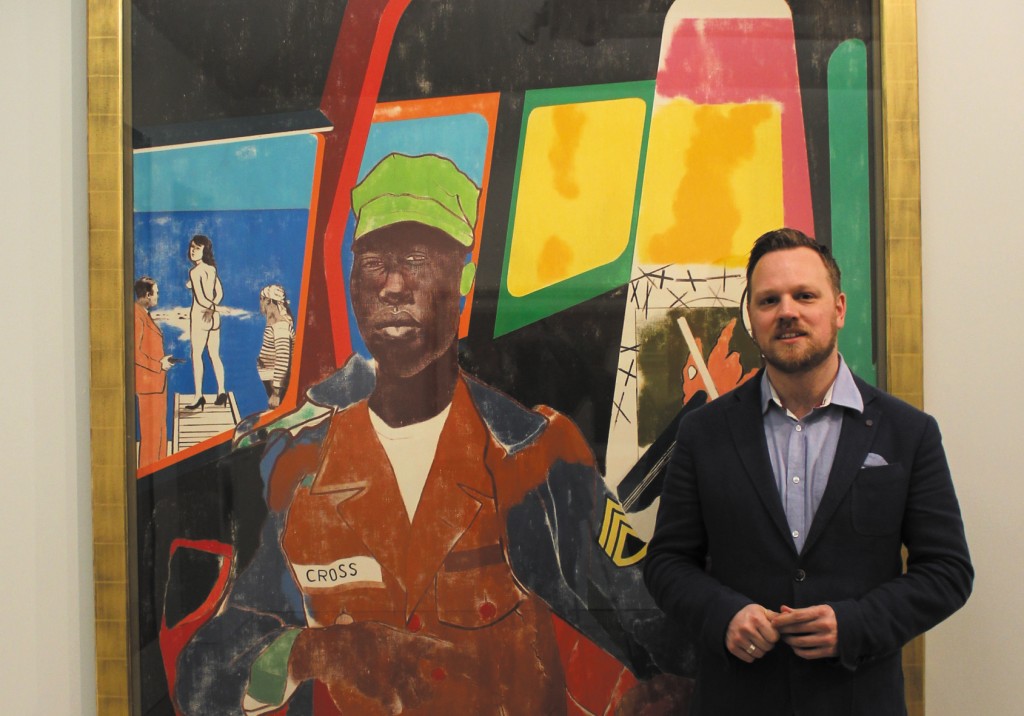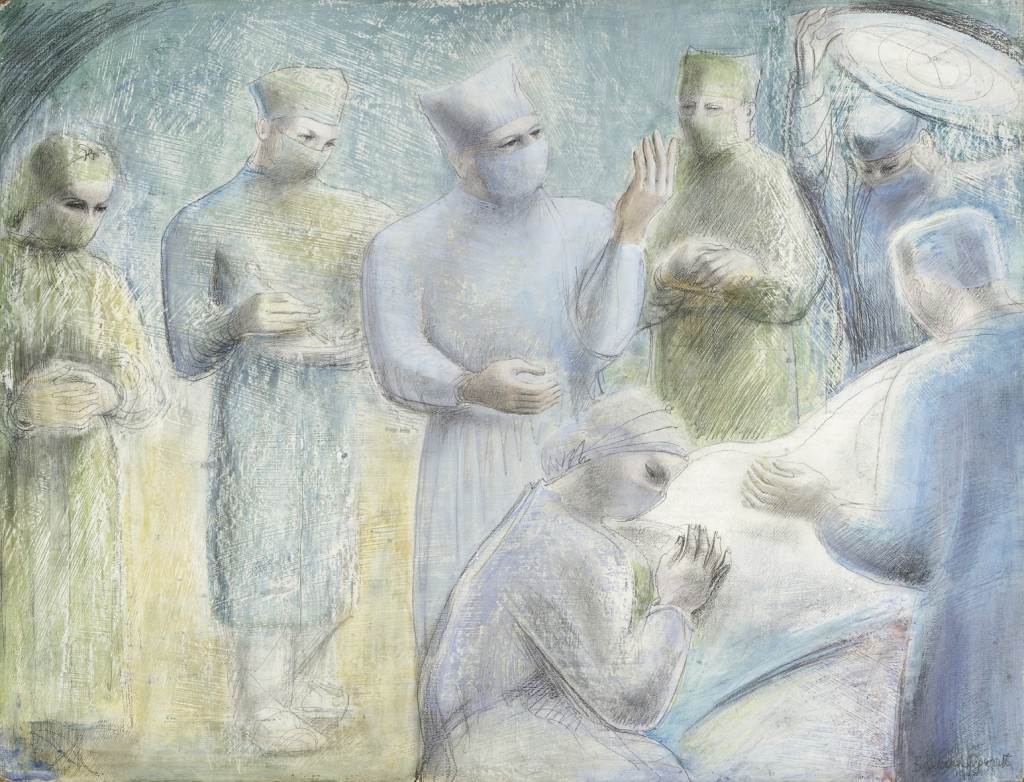
It is always a pleasure to journey with Simon Martin, Head of Collections at Pallant House Gallery in Chichester. This week I am joining him at the Gallery’s important exhibition of work by the American born artist R.B. Kitaj. The show, titled ‘Obsessions’, runs until the 16th June and includes many international loans of iconic work from the artist’s extensive oeuvre.
Kitaj is considered to be one of the most significant painters of the post-war period and the last major retrospective exhibition of his work was held at Tate in 1994. Together with his friends Francis Bacon, Frank Auerbach and Lucien Freud, he pioneered a new figurative art, challenging the prevailing trend of abstraction and conceptualism in London.
I have been back to the Kitaj exhibition several times now and on each occasion I am excited by the depth and quality of the work, but it is the large oil on canvas ‘Juan de la Cruz’, shown here with Simon Martin, that arrests my attention. “Kitaj often comments on the politics of modern culture,” Simon explains, “and this work speaks of the Vietnam War and America’s role in global politics.” The young man’s face is exquisitely observed and painted; it has a timeless quality reminiscent of 17th century portraits. I am captivated by the impassive eyes of this African American soldier. His penetrating gaze involves you with the scenes of cruelty and inhumanity that play out around him; we are not passive observers. “There is great ambiguity in this painting,” Simon interjects. “The soldier looks at you on the level. His emotional detachment invites us to question his role in the scenes depicted around him. Is he victim or perpetrator? The young man’s name, ‘Cross’, and the crosses in the centre right of the picture are rich in Christian iconography. Is this serious and intentional or a pun?’ To me, the crosses speak powerfully of Christ sharing our human suffering, united with us by the Cross, involved and not passive, the crosses symbols of hope rather than despair.
It is a remarkable achievement to present an exhibition of such importance in the heart of Sussex and Simon Martin acknowledges the hard work involved. I admire his vision, assuredness, passion and tenacity in all that he does. This is a show not to be missed and Simon deserves our thanks.
Before I leave Pallant House Gallery there is just time to see, once again, the ‘Barbara Hepworth’s Hospital Drawings’ exhibition. Barbara Hepworth embarked on this series of studies of the operating theatre in the late 1940s. They were begun on the invitation of her friend, the surgeon Norman Capener, who had saved Hepworth’s daughter, Sarah, from a near fatal illness. These then are a very personal reflection on the surgeon and theatre.

The work is figurative with a wonderful quality of light and mass, reminiscent of the early Italian Renaissance artists Giotto di Bondone (1266-1337) and Masaccio (1401-1428). Many of the pictures are worked on a gesso-type ground, a kind of fine, dry plaster, which Hepworth rubbed and scraped before applying a thin coloured oil paint wash, which she then scratched through to reveal areas of white ground. The technique was pioneered by Picasso, who shared it with Hepworth’s lover, Ben Nicholson. These studies are filled with narrative and reverence; there is a sacred quality to the figures as they prepare to operate. You sense the sculptor’s affinity with the surgeon’s craft. I share the exhibition curator Nathaniel Hepburn’s fondness for this sacred quality, expressed in ‘Prelude II’, shown here, painted in 1948. At the foot of the bed a woman sits with her hands joined and head bowed in a gesture of prayer. The characters in this story are gathered in the operating lamp’s pool of light. In the centre a man stands with his hand raised, as if in blessing, surrounded by figures whose hands are clasped, as if in prayer. In other drawings the surgeon stands at the operating table, his hands reminiscent of a priest’s celebrating Holy Communion, consecrating bread and wine at an altar.
It has been a privilege to support, through Toovey’s, the Barbara Hepworth’s Hospital Drawings exhibition, which provides such an extraordinary insight into Hepworth’s work and life. I hope you enjoy it as much as I have; it is both beautiful and unexpected.
These two extraordinary artists’ exhibitions allow us to glimpse something beyond our immediate perception of the world and our humanity, something at once sacred and secular. They continue for only a few more weeks, rare treats too good to be missed.
‘R.B. Kitaj – Obsessions’ runs until 16th June 2013 and ‘Barbara Hepworth’s Hospital Drawings’ until 2nd June 2013. For more information about the exhibitions, related talks and opening times, go to www.pallant.org.uk or telephone 01243 774557.
By Revd. Rupert Toovey. Originally published on 15th May 2013 in the West Sussex Gazette.